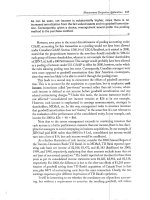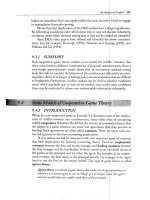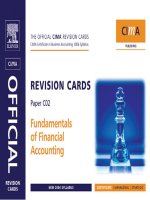Financial accounting 10th by harmin app j
Bạn đang xem bản rút gọn của tài liệu. Xem và tải ngay bản đầy đủ của tài liệu tại đây (2.7 MB, 28 trang )
Prepared by
Coby Harmon
University of California, Santa Barbara
Westmont College
J-1
Appendix J
Subsidiary Ledgers
and Special Journals
Learning Objectives
J-2
1
Describe the nature and purpose of a subsidiary
ledger.
2
Record transactions in special journals.
LEARNING
OBJECTIVE
1
Describe the nature and purpose of a
subsidiary ledger.
Used to keep track of individual balances.
Two common subsidiary ledgers are:
1. Accounts receivable (customers’)
2. Accounts payable (creditors’)
Each general ledger control account balance must equal the
composite balance of the individual accounts in the related
subsidiary ledger.
J-3
LO 1
Subsidiary Ledgers
Subsidiary Ledger Example
J-4
Illustration J-1
Relationship of general
ledger and subsidiary
ledgers
LO 1
Subsidiary Ledger Example
J-5
Illustration J-3
Relationship between general
and subsidiary ledgers
LO 1
Subsidiary Ledgers
Advantages of Subsidiary Ledgers
1. Show in a single account transactions affecting one
customer or one creditor.
2. Free the general ledger of excessive details.
3. Help locate errors in individual accounts.
4. Make possible a division of labor.
J-6
LO 1
LEARNING
OBJECTIVE
2
Record transactions in special
journals.
Used to record similar types of transactions.
Illustration J-4
Use of special journals
and the general
journal
If a transaction cannot be recorded in a special journal, the
company records it in the general journal.
J-7
LO 2
Special Journals
Question
Each of the following is a subsidiary ledger except the:
a. accounts receivable ledger.
b. accounts payable ledger.
c. customers’ ledger.
d. general ledger.
J-8
LO 2
Sales Journal
J-9
JOURNALIZING
CREDIT SALES
Illustration J-5
Journalizing the sales
journal—perpetual
inventory system
Under a perpetual inventory system, one entry at selling price in Sales
Journal results in a debit to Accounts Receivable and a credit to Sales.
Another entry at cost results in a debit to Cost of Goods Sold and a credit
to Inventory.
LO 2
Sales Journal
Illustration J-6
Posting the sales journal
POSTING
Companies make daily postings
from the sales journal to the
individual accounts receivable in
the subsidiary ledger.
J-10
LO 2
Sales Journal
Illustration J-6
Posting the sales journal
POSTING
Posting to the general ledger is
done monthly.
J-11
LO 2
Sales Journal
ADVANTAGES OF SALES JOURNAL
J-12
One-line entry for each sales transaction saves time.
Only totals, rather than individual entries, are posted
to the general ledger.
A division of labor results.
LO 2
Cash Receipts Journal
J-13
In the cash receipts journal, companies record all
receipts of cash.
The posting of the cash receipts journal is similar to the
posting of the sales journal.
LO 2
Cash Receipts Journal
Illustration: May transactions of Karns Wholesale Supply. Collections from
customers relate to the entries recorded in the sales journal in Illustration J-5.
The entries in the cash receipts journal are based on the following cash receipts.
May 1 Stockholders invested $5,000 in the business.
7 Cash sales of merchandise total $1,900 (cost, $1,240).
10
Received a check for $10,388 from Abbot Sisters in payment of invoice
No. 101 for $10,600 less a 2% discount.
12 Cash sales of merchandise total $2,600 (cost, $1,690).
17 Received a check for $11,123 from Babson Co. in payment of invoice
No. 102 for $11,350 less a 2% discount.
22 Received cash by signing a note for $6,000.
23 Received a check for $7,644 from Carson Bros. in full for invoice
No. 103 for $7,800 less a 2% discount.
28 Received a check for $9,114 from Deli Co. in full for invoice No.
104 for $9,300 less a 2% discount.
J-14
LO 2
Cash Receipts Journal
Illustration J-8
Journalizing and posting the
cash receipts journal
2014
J-15
LO 2
2014
Cash Receipts
Journal
POSTING
Illustration J-8
Journalizing and posting the
cash receipts journal
J-16
LO 2
Cash Receipts Journal
Illustration J-10
Proving the ledgers
J-17
LO 2
Cash Receipts Journal
Question
Cash sales of merchandise are recorded in the:
a. cash payments journal.
b. cash receipts journal.
c. general journal.
d. sales journal.
J-18
LO 2
Cash Receipts Journal
Question
Which of the following is not one of the credit columns in
the cash receipts journal:
a. Other accounts.
b. Accounts payable.
c. Accounts receivable.
d. Sales.
J-19
LO 2
Purchases Journal
Illustration J-12
Journalizing and posting the
purchases journal
In the purchases journal,
companies record all purchases of
merchandise on account.
J-20
LO 2
Purchases Journal
Illustration J-12
Journalizing and posting the
purchases journal
In the purchases journal,
companies record all purchases of
merchandise on account.
J-21
LO 2
Purchases Journal
Question
All of the following are advantages of using subsidiary
ledgers except they:
a. show transactions affecting one customer or one
creditor in a single account.
b. free the general ledger of excessive details.
c. eliminate errors in individual accounts.
d. make possible a division of labor.
J-22
LO 2
Cash Payments Journal
Illustration J-15
Journalizing and posting
the cash payments journal
In a cash payments journal,
companies record all disbursements
of cash.
J-23
LO 2
Cash Payments Journal
Illustration J-15
Journalizing and posting
the cash payments journal
In a cash payments journal,
companies record all disbursements
of cash.
J-24
LO 2
Cash Payments Journal
Question
Credit purchases of equipment or supplies other than
merchandise are recorded in the:
a. cash payments journal.
b. cash receipts journal.
c. general journal.
d. purchases journal.
J-25
LO 2









